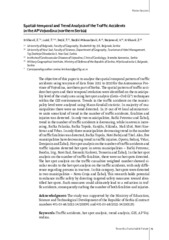Приказ основних података о документу
Spatial-temporal and Trend Analysis of the Traffic Accidents in the AP Vojvodina (northern Serbia)
| dc.contributor | Marković, Slobodan | |
| dc.creator | Kričković, Emina | |
| dc.creator | Lukić, Tin | |
| dc.creator | Srejić, Tanja | |
| dc.creator | Stojšić- Milosavljević, Anastazija | |
| dc.creator | Stojanović, Vladimir | |
| dc.creator | Kričković, Zoran | |
| dc.date.accessioned | 2023-11-09T09:58:55Z | |
| dc.date.available | 2023-11-09T09:58:55Z | |
| dc.date.issued | 2023 | |
| dc.identifier.isbn | 978-86-7031-650-8 | |
| dc.identifier.uri | http://gery.gef.bg.ac.rs/handle/123456789/1530 | |
| dc.description.abstract | The objective of this paper is to analyse the spatial-temporal pattern of traffic accidents using ten years of data from 2011 to 2020 for the Autonomous Province of Vojvodina, northern part of Serbia. The spatial pattern of traffic accident hot spots and their temporal evolution were identified on the municipality level of the study area using hot spot analysis (Getis–Ord Gi*) techniques within the GIS environment. Trends in the traffic accidents on the municipality level were analysed using Mann-Kendall statistic. In majority of municipalities there were no trend detected. In 15 out of 45 local administrative units some kind of trend in the number of traffic accidents, fatalities and injuries was detected. In only two municipalities, Bački Petrovac and Žabalj, trend in the number of traffic accidents is decreasing, while in seven is increasing, Bačka Palanka, Bačka Topola, Kanjiža, Kikinda, Mali Iđoš, Novi Kneževac and Vrbas. In only three municipalities decreasing trend in the number of traffic fatalities was detected, Bačka Topola, Novi Bečej and Titel. Also, five municipalities have decreasing trend in traffic injuries, Opovo, Sečanj, Vršac, Zrenjanin and Žabalj. Hot spot analysis on the number of traffic accidents and traffic injuries detected hot spots in seven municipalities – Bački Petrovac, Beočin, Irig, Novi Sad, Sremski Karlovci, Temerin and Žabalj. In the hot spot analysis on the number of traffic fatalities, there were no hot spots detected. The hot spot analysis on the traffic casualties weighted number showed similar results to the hot spot analysis on the traffic accidents, with only difference regarding persons in tractors. In this category, hot spots were detected in two municipalities – Nova Crnja and Žabalj. This research holds potential to enhance traffic safety by directing targeted safety measures toward identified hot spots. Such measures could ultimately lead to a reduction in traffic accidents, consequently curbing the number of both fatalities and injuries. | sr |
| dc.language.iso | en | sr |
| dc.publisher | Novi Sad : University of Novi Sad - Faculty of Sciences, Department for Geography, Tourism and Hotel Management | sr |
| dc.relation | info:eu-repo/grantAgreement/MESTD/inst-2020/200091/RS// | sr |
| dc.relation | info:eu-repo/grantAgreement/MESTD/inst-2020/200125/RS// | sr |
| dc.rights | openAccess | sr |
| dc.rights.uri | https://creativecommons.org/licenses/by/4.0/ | |
| dc.source | Book of Abstracts of the International conference "Natural resources and environmental risks: Towards a Sustainable Future", Novi Sad | sr |
| dc.subject | Traffic accidents | sr |
| dc.subject | hot spot analysis | sr |
| dc.subject | trend analysis | sr |
| dc.subject | GIS | sr |
| dc.subject | AP Vojvodina | sr |
| dc.title | Spatial-temporal and Trend Analysis of the Traffic Accidents in the AP Vojvodina (northern Serbia) | sr |
| dc.type | conferenceObject | sr |
| dc.rights.license | BY | sr |
| dc.citation.spage | 73 | |
| dc.identifier.fulltext | http://gery.gef.bg.ac.rs/bitstream/id/3362/Sustainable_future_abs-book-84.pdf | |
| dc.identifier.rcub | https://hdl.handle.net/21.15107/rcub_gery_1530 | |
| dc.type.version | publishedVersion | sr |


